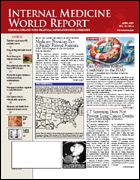Publication
Article
Internal Medicine World Report
Allergic Fungal Sinusitis a Unique Clinical Entity
Author(s):
SAN DIEGO—Allergic fungal sinusitis appears to constitute a distinct form of chronic rhinosinusitis and may require antifungal therapy and other modes of treatment rather than antibiotics alone, according to new data presented at the American Academy of Allergy, Asthma & Immunology annual meeting.
Alternaria
Mayo Clin Proc.
Although first described in 1981, whether allergic fungal sinusitis is a separate entity of chronic rhinosinusitis is still controversial. Jens?U.?Ponikau,?MD, of the Mayo Clinic, Rochester, and colleagues previously demonstrated that (a common fungus) was present in the nasal mucous of 96% of patients with chronic rhinosinusitis and in 100% of the controls ( 1999; 74: 877-884).
Alternaria
However, only the patients with chronic rhinosinusitis developed an immune response with eosinophilic infiltration, as well as a specific immunoglobulin (Ig) G anti- antibody response. These findings fueled speculation that eosinophilic chronic rhinosinusitis was a fungal-driven disease that was independent of IgE-mediated allergy and, as a result, allergic fungal sinusitis would not qualify as a separate entity.
In this new study, “What we showed is that allergic fungal sinusitis is a truly allergic condition,” Raymond G. Slavin, MD, director, Section of Allergy & Immunology at St. Louis University School of Medicine, Mo, said. “The patients are atopic. They have sensitivity to many allergens. They also have increased serum IgE levels, and they have positive skin tests. In addition, they show IgE on immunoblots to most molds,” he added.
“In contrast, Dr Ponikau feels that chronic rhinosinusitis patients are basically not allergic. He believes they don’t have positive skin tests, don’t have increased IgE levels, and have an IgG response to molds rather than IgE,” Dr Slavin said. “We showed in our study that they do not have IgE response to molds on immunoblot.”
In this study, 84 patients with chronic rhinosinusitis and nasal polyposis were divided into 2 groups, based on the presence or absence of confirmed fungal involvement, either by histopathology or culture of a surgical specimen or inspissate. A total of 66 patients had positive culture for fungal hyphae; the remainder’s cultures were fungal negative.
Alternaria
IgE and anti- antibody levels were significantly higher in those with allergic fungal sinusitis than in those with chronic rhinosinusitis. Immunoblotting showed remarkable IgE sensitivity to all 7 fungi tested in the allergic fungal sinusitis patients, with 90% showing reactivity to all fungi. Conversely, fewer than 10% of chronic rhinosinusitis patients had IgE reactivity to all 7 fungi.
IMWR
Dr Slavin told that IgE appears to play a significant role in the pathogenesis of allergic fungal sinusitis.
“This is a highly controversial area,” said coinvestigator Patricia Hutcheson, also of St. Louis University School of Medicine. “It is the allergic part that is causing the controversy. There is not an argument about the label of fungal sinusitis, but whether there is such a thing as allergic fungal sinusitis.”
The diagnosis of allergic fungal sinusitis requires the identification of allergic mucin, an extramucosal inspissate containing lymphocytes and eosinophils, with or without Charcot-Leyden crystals (breakdown products of eosinophils), and fungal hyphae. The disease is also characterized by nasal polyposis and IgE sensitivity to the offending fungus. If no fungal elements or hyphae are observed on histopathology, culture of the mucin must reveal fungal growth before the diagnosis can be made.






